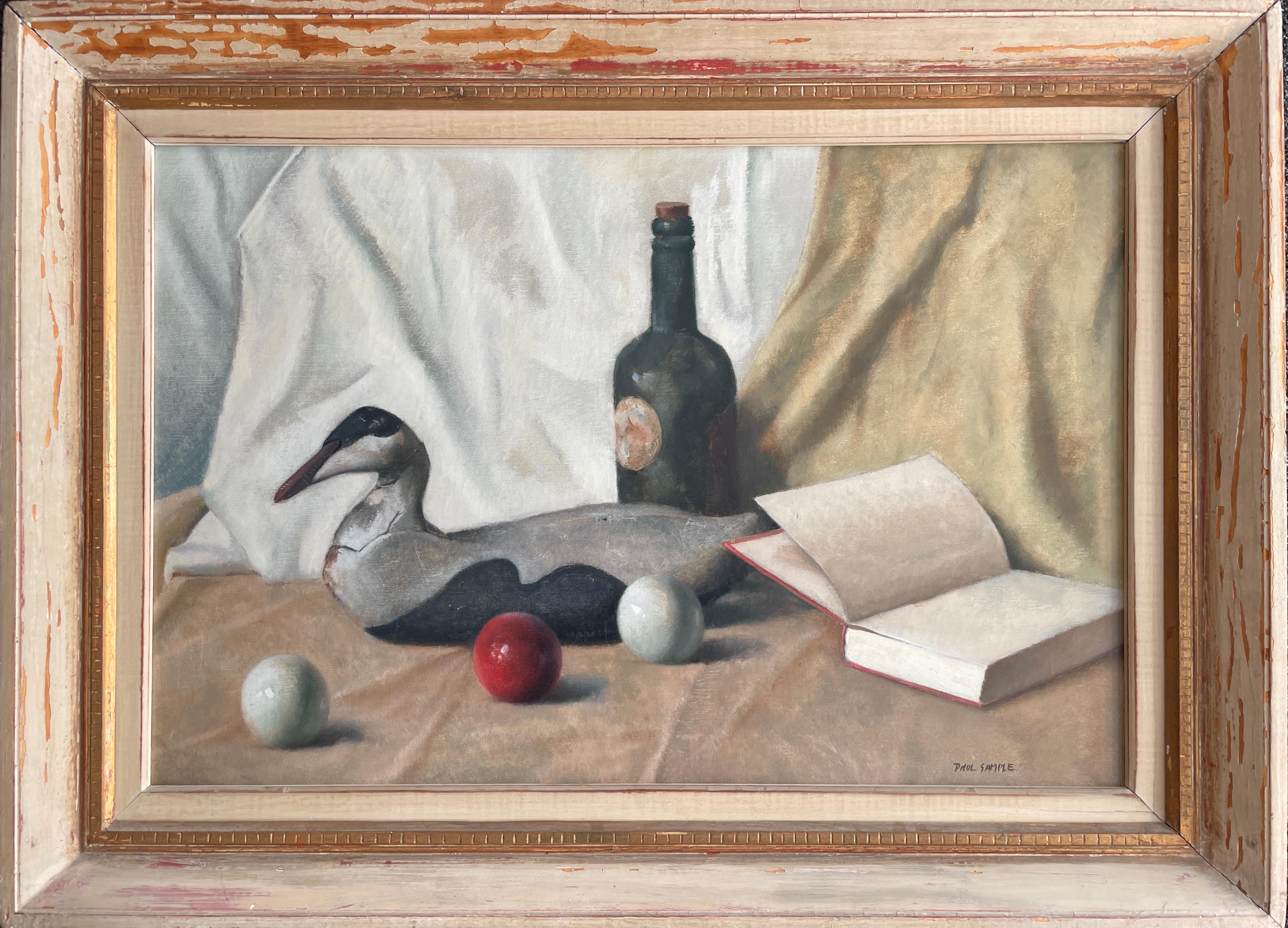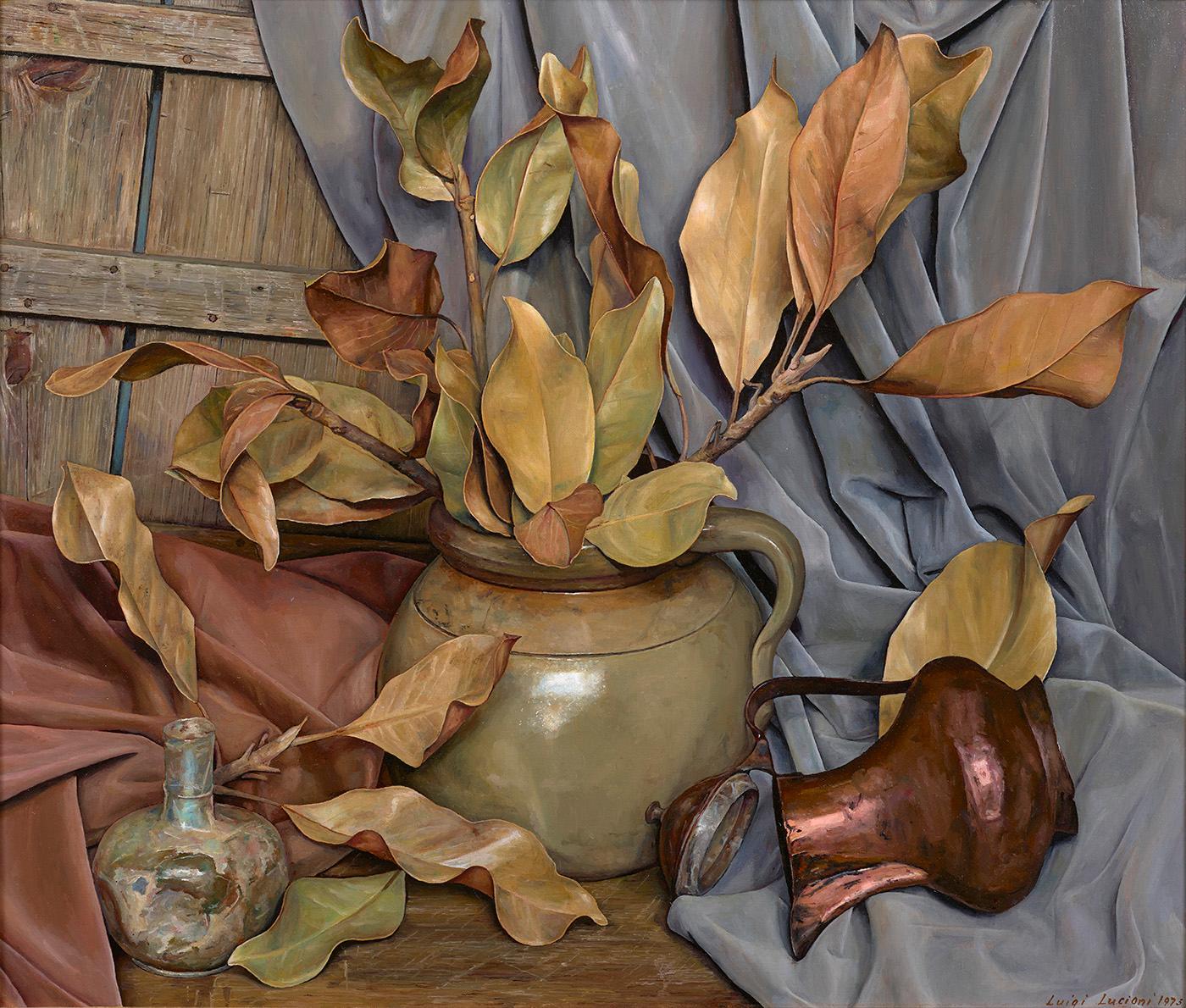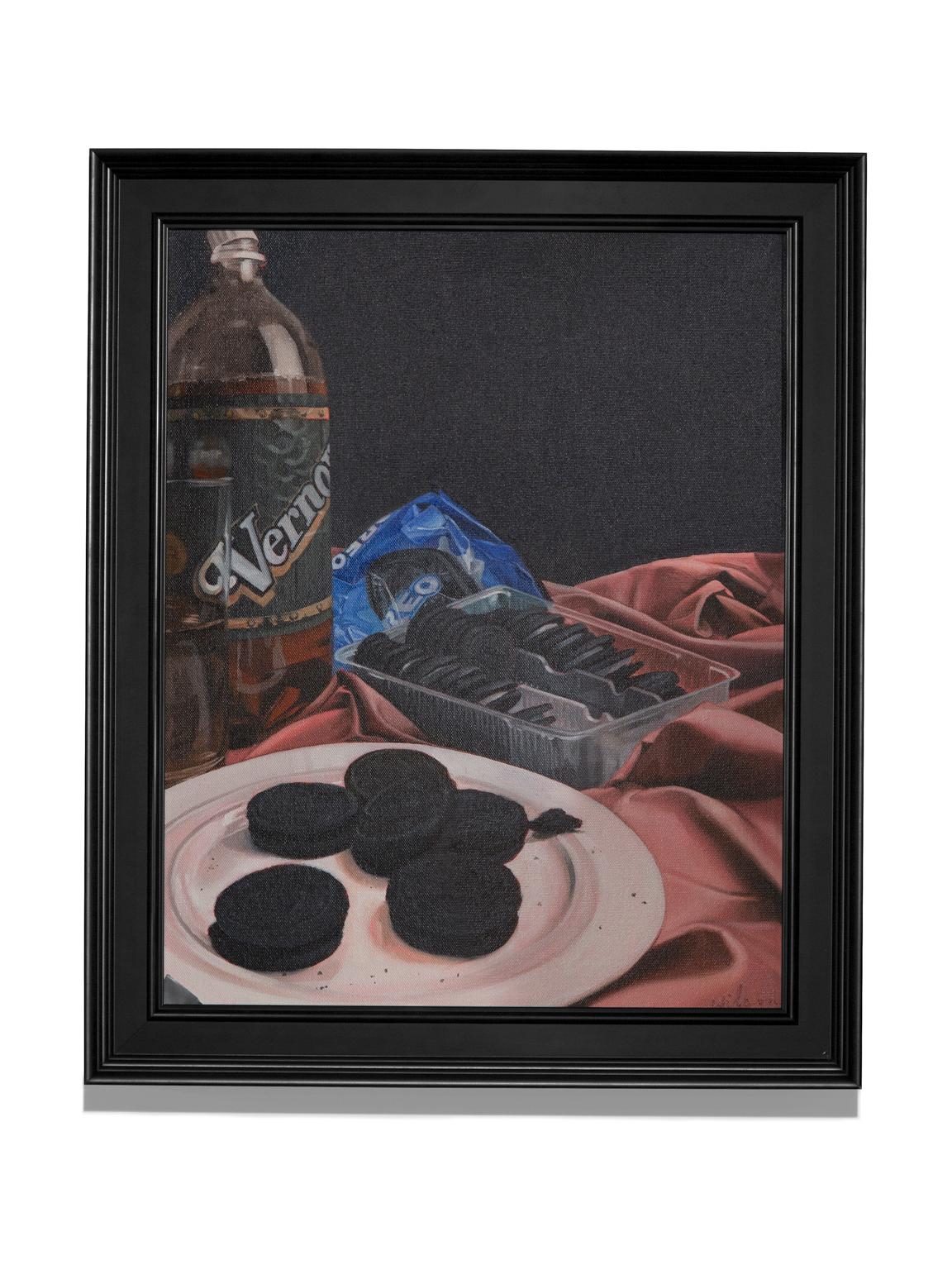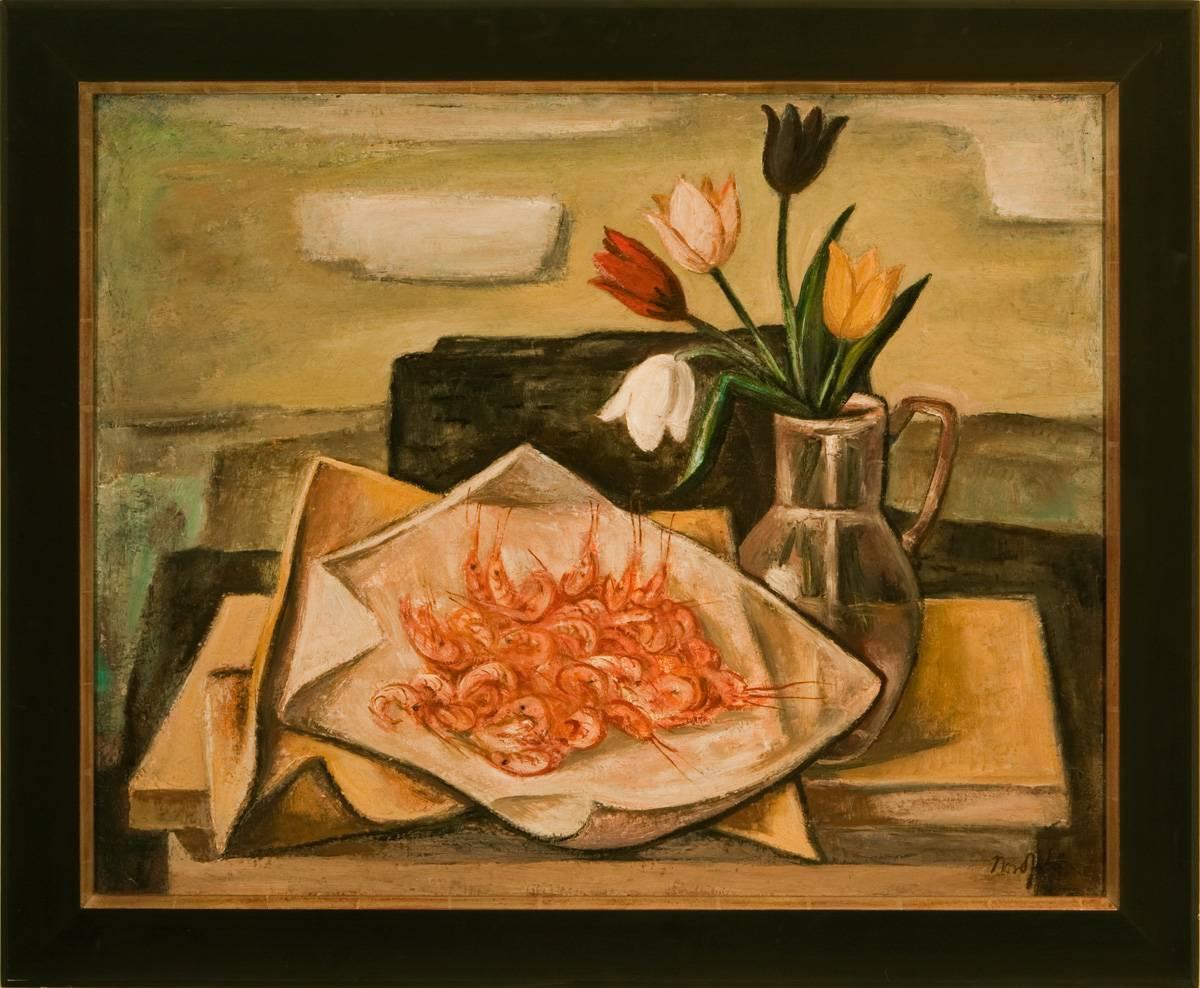Items Similar to "Ethnographic Still Life, " Edith Kramer, African Mask and Shofar, Art Therapy
Want more images or videos?
Request additional images or videos from the seller
1 of 8
Edith Kramer"Ethnographic Still Life, " Edith Kramer, African Mask and Shofar, Art Therapy
About the Item
Edith Kramer (1916 - 2014)
Still Life with Mask, n.d.
Oil on canvas
26 x 20 inches
Signed and titled on the stretcher
Provenance:
Estate of the artist
Kramer was born in Vienna, Austria-Hungary in 1916. At age 13 Kramer began art lessons with Friedl Dicker. Dicker was graduate of the Bauhaus in Weimar, Germany and was an artist and art teacher of note. Kramer studied drawing, sculpture and painting, and was influenced by the method for teaching art developed by Bauhaus artist Johannes Itten. It was in 1934 after Kramer graduated from Realgymnasium that she, then 18, followed Dicker to Prague to continue to study under her. During this time in Prague, Kramer witnessed the therapeutic impact of art when she assisted Dicker in teaching art to the children of political refugees.
With the threat of Nazi invasion looming, Kramer took refuge in America in 1938. In New York City, she worked for three years teaching sculpture at a progressive school called the Little Red School House. During World War II Kramer worked as a machinist at a tool and die shop in the Soho district of New York City. She stayed after her shift to draw the other workers in their industrial setting. These works were rendered in the social realist style. In 1947 Kramer visited some of the earliest known artwork, in the caves at Lascaux. Kramer spoke of these cave paintings as an example of the universal language of art.
At the age of 33 she returned to New York City, with hopes of making a living as an artist. Still in her 33rd year, Kramer was offered a job at Wiltwyck School for Boys, a school and residential treatment facility for children with behavioral and emotional needs. This job was arranged for her by psychoanalyst and board member at Wiltwyck, Dr. Viola Bernard. Dr. Bernard gave Kramer the title, "Art Therapist," noting that few teachers were willing to work with such challenging students. It was here that Kramer worked with disturbed boys, ages 8 through 13, for the following seven years.
Raised in a family which was interested in psychoanalytic theory, Kramer herself became a follower of Sigmund Freud. Kramer especially believed in the concept of sublimation. Freudian theory describes sublimation as a process in which primitive urges coming from the id are transformed into socially productive activities that lead to gratification of the original urge. Kramer's training was in art, art education and psychoanalytically informed psychotherapy. Kramer believed sublimation to be one of the most vital goals of art therapy. Through art, she believed, negative and destructive emotions and urges are transformed into useful products. Kramer asserted that the success of the therapy could be measured by the visual product.
Though Kramer and her fellow pioneer of American art therapy, Margaret Naumburg, had a similar goal of combining art and psychology, their beliefs took a different path where Kramer began to declare that it was art as therapy, and Naumburg instead promoted art in therapy.
Kramer's life work was spent with children and adolescents that were often unable to explain their feelings through the use of words. In 1958 Kramer published Art Therapy in a Children's Community, based on her time working with the students at the Wiltwyck School. Kramer also worked at Jacobi Hospital in their child psychiatric ward for 13 years. In 1971 Kramer published Art as Therapy with Children. Kramer wrote in her books of her experiences with her clients. Kramer worked for 14 years at the Jewish Guild for the Blind. In 1976 Kramer, with the help of Dr. Laurie Wilson, founded the graduate program in Art Therapy at New York University. While at NYU, Kramer came up with an important method of the program and called it, “the Art Therapist third hand intervention.” This concept called for the versatility of the art therapist. "The third hand can be summed up as the art therapist's ability to facilitate a person's artistic process (such as strategically helping the individual mix paints for a desired color or intervening at critical moments during art making)". It is important to note that Kramer believed that product was as important as process in Art Therapy. She felt denying the client the gratification of the end product was robbing them. Kramer believed that Art Therapy should fall more in the humanities area than psychology. She asserted that art therapy was not a replacement, but a supplement to psychotherapy.
When in active practice, Kramer maintained a studio where she painted, etched, and sculpted. Kramer believed that art should be personal and reflective of the artist's environment. She often depicted physical, tangible objects such as herself, other people, landscapes, and cityscapes. She preferred painting with expressive colors. Kramer argued that art therapists must make their own art in order to cope with "exhausting clinical work."
Edith Kramer became a U.S. citizen in 1944. Kramer received an honorary doctorate in 1996 from Norwich University in Northfield, Vermont. She helped develop one of the country's earliest art therapy graduate degree programs at New York University. She continued to work in NYU's Graduate Art Therapy Program from 1973 to 2005 as an adjunct professor and was an assistant professor in the Graduate Art Therapy Program at George Washington University in Washington, D.C. The American Art Therapy Association gave her the award of "Honorary Life Member,” a mark of highest esteem. Kramer eventually returned to her home in Austria. She died in 2014.
In 2014, Kramer was posthumously awarded the inaugural Myra Levick Award for Excellence in Art Therapy. The award was given "[f]or her role as an artist and art therapist whose ability to communicate with troubled children through art is a treasured legacy of a pioneer in our field. Her idea of art as therapy with her emphasis on the creative process itself as healing is a major contribution to art therapy theory".
- Creator:Edith Kramer (1916 - 2014, American, Austrian)
- Dimensions:Height: 32 in (81.28 cm)Width: 26 in (66.04 cm)
- Medium:
- Movement & Style:
- Period:
- Condition:Excellent.
- Gallery Location:New York, NY
- Reference Number:1stDibs: LU184129903942
About the Seller
5.0
Platinum Seller
These expertly vetted sellers are 1stDibs' most experienced sellers and are rated highest by our customers.
Established in 2021
1stDibs seller since 2022
59 sales on 1stDibs
Typical response time: 1 hour
- ShippingRetrieving quote...Ships From: New York, NY
- Return PolicyA return for this item may be initiated within 3 days of delivery.
More From This SellerView All
- "Sunflowers, " Frank London, Modernist Yellow Floral Still Life with WindowLocated in New York, NYFrank Marsdon London (1876 - 1945) Sunflowers Oil on canvas 31 x 22 inches Signed lower right Exhibited: Pittsburgh, Carnegie Museum of Art. Frank Marsden London was born in the small Southern town of Pittsboro in central North Carolina in 1876. When he reached adulthood, London attended the University of North Carolina...Category
1920s American Modern Still-life Paintings
MaterialsCanvas, Oil
- "Still Life of Fruit, " Albert Swinden, American Abstract Association, AAABy Albert SwindenLocated in New York, NYAlbert Swinden (1901 - 1961) Still Life of Fruit, 1937 Oil on canvas 18 x 30 inches Provenance: Graham Gallery, New York Albert Swinden (1901–1961) was an English-born American abstract painter. He was one of the founders of the American Abstract Artists, and he created significant murals as part of the Federal Art Project. Albert Swinden was born in Birmingham, England in 1901. When he was seven, he moved with his family to Canada, and in 1919 he immigrated to the United States. He lived in Chicago, where he studied for about a year and a half at the Art Institute. He then relocated to New York City, where his art education continued briefly at the National Academy of Design. He soon changed schools again, to the Art Students League, which he attended from 1930 to 1934. He studied with Hans Hofmann and gained an appreciation for Synthetic Cubism and Neoplasticism. According to painter and printmaker George McNeil, Swinden "could have influenced Hofmann ... He was working with very, very simple planes, not in this sort of Cubistic manner. Swinden was working synthetically at this time." While still a student, Swinden began teaching at the Art Students League, in 1932. Swinden married Rebecca Palter (1912–1998), from New York. Their daughter, Alice Swinden Carter, also became an artist. Carter, who attended the School of the Museum of Fine Arts, Boston, received an award from the Institute of Contemporary Art, Boston for her large sculptures. Swinden was hired for the Federal Art Project (FAP) of the Works Progress Administration (WPA), and he is best known for the murals which he painted as part of that project. In 1935, New York City Mayor Fiorello La Guardia attended the opening of the inaugural exhibit at the Federal Art Project Gallery, accompanied by Audrey McMahon, New York regional director for the Works Progress Administration/Federal Art Project. Among the works on display was Abstraction, a sketch by Swinden; it was the design for a mural planned for the College of the City of New York. A newspaper account described it as consisting of "brightly colored T-squares, triangles and rulers in horizontal, vertical and diagonal positions". La Guardia asked what it was, and upon being told it was a mural design, he said he didn't know what it depicted. Someone joked that it could be a map of Manhattan. The displeased mayor stated that "if that's art, I belong to Tammany Hall." (Tammany Hall, which the Republican mayor referenced, was the New York Democratic Party political society.) Fearing that the mayor's negative attitude could jeopardize the future of abstract art within the Federal Art Project, McMahon dispatched an assistant to summon an artist who could speak to the mayor in defense of abstraction. The assistant returned with Arshile Gorky. Swinden played an important role in the founding of the American Abstract Artists. In 1935, he met with three friends, Rosalind Bengelsdorf, her future husband Byron Browne, and Ibram Lassaw, with the goal of exhibiting together. The group grew and started meeting in Swinden's studio, which adjoined those of Balcomb and Gertrude Greene...Category
1930s Modern Still-life Paintings
MaterialsCanvas, Oil
- "Floral Still Life Arrangement" Frederick Jessup, Butterflies, Wine BottleBy Robert JessupLocated in New York, NYFrederick Arthur Jessup Still Life Arrangement Signed lower left Oil on canvas 18 1/2 x 22 inches Provenance: Findlay Galleries, New York Private Collection, New YorkCategory
Mid-20th Century Modern Still-life Paintings
MaterialsCanvas, Oil
- "Fruit" Georgina Klitgaard, Apples and Pears Still Life, Woodstock Female ArtistBy Georgina KlitgaardLocated in New York, NYGeorgina Klitgaard Apples and Pears Still Life Signed lower right Oil on canvas 8 x 10 inches Georgina Klitgaard’s art has sometimes gotten lost in the critical propensity to assign...Category
Early 20th Century Modern Still-life Paintings
MaterialsCanvas, Oil
- "Candelabra, " Edward Millman, Colorful Abstract Expressionist Still LifeLocated in New York, NYEdward Millman (1907 - 1964) Candelabra, 1962 Signed lower right; titled and dated on the reverse Oil on canvas 41 3/4 x 31 1/2 inches Provenance: The ...Category
1960s Abstract Abstract Paintings
MaterialsCanvas, Oil
- "Floral Bouquet Still Life, " Everett Lloyd Bryant, American ImpressionismBy Everett Lloyd BryantLocated in New York, NYEverett Lloyd Bryant (1864 - 1945) Floral Bouquet Still Life Oil on canvas 30 x 25 inches Signed lower right; signed on the reverse and on stretc...Category
Early 20th Century American Impressionist Still-life Paintings
MaterialsCanvas, Oil
You May Also Like
- The Wood Decoy oil painting by Paul SampleBy Paul SampleLocated in Hudson, NYSigned "Paul Sample" lower right; titled and signed verso: "The Wood Decoy" & "Paul Sample" in pencil in the artist's hand. Paul Sample was an acclaimed Ne...Category
Mid-20th Century American Modern Still-life Paintings
MaterialsCanvas, Oil
- Harmony in Minor KeyBy Luigi LucioniLocated in New York, NYSigned and dated lower right: Luigi Lucioni 1973Category
Late 20th Century American Modern Still-life Paintings
MaterialsCanvas, Oil
- Dance Wands, Modernist Southwestern Still Life and Cultural CommentaryLocated in Doylestown, PA"Dance Wands" is a 36 x 24 inches, oil on canvas painting by American modernist and surrealist, female artist Peter Miller. The work is painted in a vibrant color palette, signed and...Category
1950s American Modern Still-life Paintings
MaterialsCanvas, Oil
- "Vernors & Oreos" Treats for Stevie Wonder, Still-Life, Oil, ColorfulLocated in Detroit, MISALE ONE WEEK ONLY “Vernors and Oreos” is a clever colorful piece by Richard Wilson that is full of significant meaning for native Detroiters. The beverage and cookies are specific treats for many people in Detroit and Michigan, but for Stevie Wonder in particular who is also a native Detroiter. The soda is produced and has been manufactured in the city of Detroit since 1862 by the Vernors Co. The story goes that prior to his concerts, Stevie Wonder, always requested that Vernors' Ginger Ale and Oreos be provided in his dressing room. Wilson has a great admiration for Stevie Wonder and as a gift to the city of Detroit he painted a mural of Stevie Wonder on an outside wall of the Music Hall. The “Ginger Ale and Oreos” painting...Category
2010s American Modern Still-life Paintings
MaterialsCanvas, Oil
- "Shrimp"By Bror Julius Olsson NordfeldtLocated in Lambertville, NJSigned Lower Right Bror Julius Olsson “B.J.O.” Nordfeldt (1878 - 1955) Bror Julius Olsson was born in Tullstrop, Sweden in 1878. He immigrated to the United States in 1891, later adopting his mother’s maiden name of Nordfeldt. Beginning his art studies at the Art Institute of Chicago where he was chosen to assist fellow artist, Albert Herter, with a large mural project for the McCormick Harvester Company. In 1900, he was sent to Paris by McCormick to help set up the completed mural at the Paris Exposition. While there, he studied briefly at the Academie Julian before traveling to England to study woodblock printmaking under F. Morley Fletcher. Returning to Chicago in 1903, Nordfeldt would spend the next ten years painting mainly figurative works in an academic style similar to that of the Old Masters. By the mid-teens he had developed a bold dramatic modernist style and divided his time between New York and Provincetown, Massachusetts. There, he invented the “Provincetown Print...Category
1940s American Modern Still-life Paintings
MaterialsCanvas, Oil
- Large Landscape Scene Bay Area Artist "Two Ships Passing"Located in Arp, TXTrung Quoc Tran 1980's "Ships Passing" Oil on Canvas 35.5" x 47.5" unframed $1900 No Signature *Listed price reflects custom framing selected by seller. Please expect framing time be...Category
Late 20th Century American Modern Landscape Paintings
MaterialsCanvas, Oil
Recently Viewed
View AllMore Ways To Browse
Original African Art
African American Art Signed
20x26 Art
Dior Shop
Dior Shopping
Vintage Concept Art
Make Art Not War
Original Art African American
Art Objects From Africa
Original African American
Life Mask
Oil Painting With African American
Sublimation Art
Artwork By African American Artists
Framed African Artwork
Africa Mask
Refugee Art
Weimar Art



